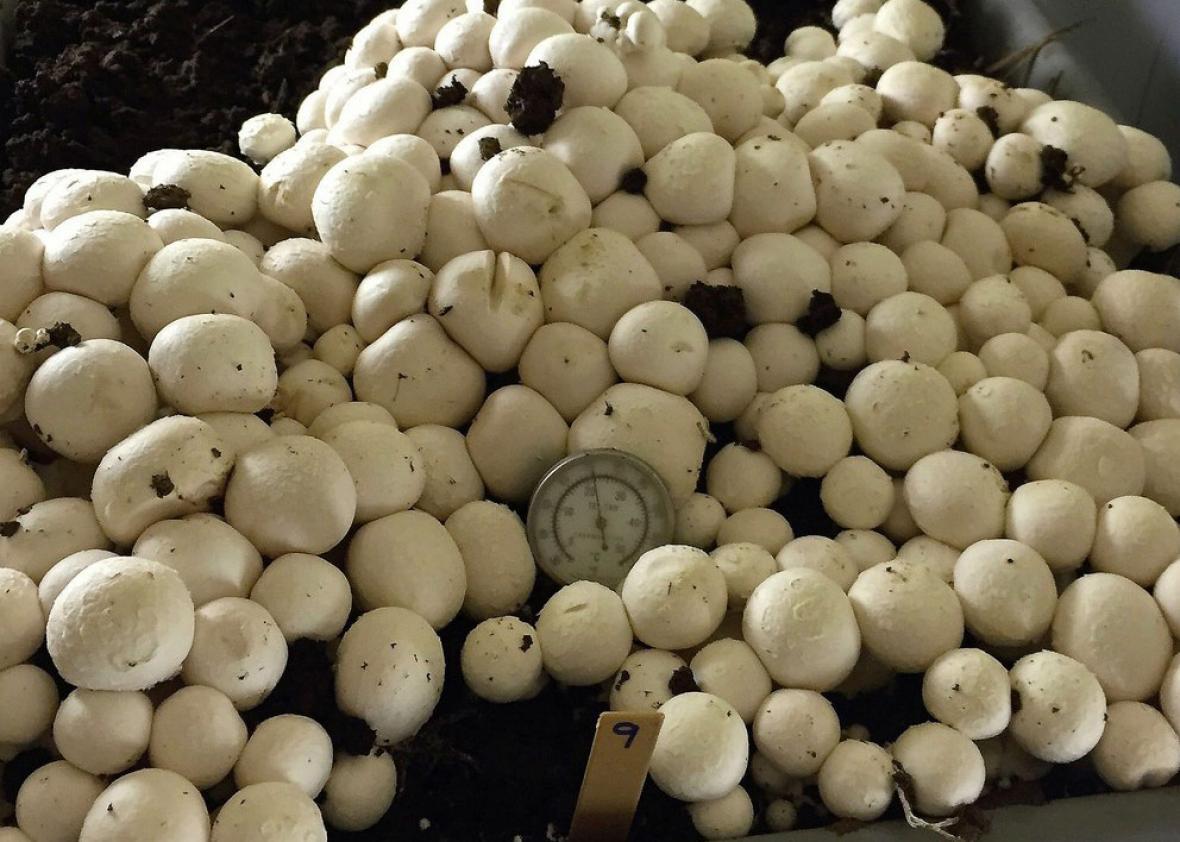In April 2016, an unlikely thing made headlines: the common white button mushroom.
“Gene-Edited CRISPR Mushroom Escapes US Regulation,” wrote Nature.
“What’s a GMO? Apparently Not These Magic Mushrooms,” wrote Grist.
And from MIT Technology Review: “Who Approved the Genetically Engineered Foods Coming to Your Plate? No One.”
The white button mushroom in question looked like any other in the grocery store, with one imperceptible difference: It was missing a gene that codes for an enzyme called PPO, or polyphenol oxidase, which makes mushrooms turn brown when they’re bruised or cut. Scientists at Pennsylvania State University essentially turned off this PPO gene—one of six in the mushroom—with a new gene-editing tool called CRISPR, or clustered regularly interspaced short palindromic repeats. CRISPR is a bit like a biological word processor. It zooms to a specific genetic sequence in any living thing—the biotech equivalent of using Ctrl+F. Then, the tool can add, delete, or replace genetic information like an editor tweaking a sentence.
While the Penn State scientists used biotechnology to manipulate the mushroom’s genes, their work didn’t trigger government oversight, in part because current law doesn’t necessarily apply to food made with CRISPR. The case highlights a chronic challenge with biotechnology regulation: It can’t keep up with the fast pace of innovation. No surprise there: The relevant laws haven’t had a proper update in more than 30 years.
Not only that, the regulations are “cobbled together,” says Jaydee Hanson, a senior policy analyst at Center for Food Safety, an advocacy group. “If you were writing a sci-fi novel, your editor would say, ‘That’s just too unbelievable. No one would ever do it that way.’ ”
The CRISPR mushroom doesn’t appear to pose a health or environmental threat, so in this case the regulatory gaps may not matter. But what about a potentially damaging biotech creation made the same way? How will we regulate synthetic organisms made with technologies that don’t yet exist? These questions aren’t just about food, as important as that is—they’re also key for any biotech or synbio product, such as mosquitoes engineered to curb diseases and microbes made from scratch.
Depending on whom you talk to, the CRISPR’d mushroom isn’t strictly defined as synthetic biology. Still, genetic technology exists on a continuum, and the regulatory conundrum the mushroom raises is relevant to any organism tweaked in a lab.
Over the past two years, policymakers had a fleeting chance to improve biotech laws—and they missed it. Now that we’re in the wild and unpredictable world of the Trump administration, the future of biotech regulation is a big fat question mark.
To understand biotech regulations, we have to go back in time to 1986, when the cool kids were pegging their jeans, Top Gun was in the theaters, and Lionel Richie and Bananarama dominated the airwaves.
Another trend back then: recombinant DNA. Scientists discovered this genetic engineering tool in the early 1970s, when they first swapped genes from one species into another using the bacteria E. coli. The discovery was a landmark for biotechnology. By the 1980s, companies were commercializing microbes and plants made with recombinant DNA, and regulators’ ears perked up.
The decision fell to the White House Office of Science and Technology Policy, which has two main jobs. The first is to advise the president on matters of science, tech, and engineering. The second is to help coordinate multiple agencies on scientific policy. Rather than writing a new law, the OSTP decided to fit genetically engineered products into existing laws. The result, called the Coordinated Framework for the Regulation of Biotechnology, published in June 1986. A small update in 1992 didn’t change much.
Under the coordinated framework, regulation falls to the Environmental Protection Agency, the U.S. Department of Agriculture, and the Food and Drug Administration.

The EPA’s job is to protect human health and the environment. Several laws allow the EPA to do this, but the two relevant for biotech regulation relate to pesticides and toxic materials. Under the coordinated framework, the EPA can regulate any biotech organisms that produce these chemicals in some way. A genetically engineered crop that makes its own insecticide, for example, would trigger EPA’s oversight on pesticides, while a microbe altered to produce biofuel would trigger the rules for potentially toxic chemicals.
The USDA’s job, in part, is to protect U.S. agriculture. When it comes to biotech, the relevant laws that give USDA power relate to plant health. When the coordinated framework first published, the state-of-the-art genetic engineering—recombinant DNA—used microbes to deliver new genes. In crops, for example, scientists used agrobacterium, a bacterium that can infect plants. It’s a weird way to apply the law—these microbes aren’t likely to hurt crops. But the microbes are technically plant pathogens, which gives the USDA the authority to regulate any crop made this way.
As for the FDA, part of its job is to keep our food safe. Under the coordinated framework, companies proposing to sell a biotech food may submit to a voluntary safety review, to prove that it’s not going to poison anyone or give them a horrifying allergic reaction.
The original coordinated framework was a messy solution, but it worked OK for the technologies that were available back in the ’80s and ’90s. Today? Not so much. Take the CRISPR’d mushroom. Because the mushroom doesn’t produce pesticides or potentially toxic chemicals, the EPA had no reason to regulate it. The Penn State scientists who made the mushroom didn’t use microbes to deliver DNA—CRISPR doesn’t require that step—and so their work didn’t trigger USDA oversight. As for the voluntary FDA review, the agency hasn’t published anything on the mushroom so far.
Policymakers knew the coordinated framework was rickety even before the mushroom came along. In July 2015, the Obama administration asked the OSTP to take another look at the policy “to ensure that the system is prepared for the future products of biotechnology.”
To do this, the OTSP proposed three steps. One was to commission a report from the National Academies of Science exploring new biotech that may come out over next five to 10 years (more on this in a minute). For the other two, the agencies had to update their role in current biotech regulation and spell out a long-term strategy for future products.
The update took more than a year and included a series of closed and public meetings. A draft published last September, and the final version came out in early January. It was a lot of work for an underwhelming document. Rather than update the coordinated framework, the document lists a series of hypothetical biotech products and explains how each agency might regulate them. But none of the hypothetical exercises explored how products made with new technologies, like the CRISPR mushroom, may fit the current rules.
“I thought it was a missed opportunity,” says Jennifer Kuzma, a professor of science and technology policy and co-director of the Genetic Engineering and Society Center at North Carolina State University.
A better approach may have been to blow the whole thing up and start over: Write a new law that could adapt to future technologies. Such a law would have a broad scope that could capture any biotech or synbio product, regardless of how it’s made. Ideally, the law would also be more elastic when it comes to risk. “We should let the traits of the organism” determine the level of regulation, says Greg Jaffe, biotechnology director for the Center for Science in the Public Interest. “Things that are potentially more risky should get more scrutiny, and things that are potentially less risky should have less scrutiny.”
Of course, writing new biotech laws would require legislative approval—a tough job in any year, made even more unlikely in today’s hyperpartisan, dysfunctional Congress.
But there are other ways biotech laws could change. Remember, the OSTP also tasked the agencies with a long-term strategy for future biotech products. In January, just days before Obama left office, the FDA published draft guidance on regulating genetically altered animals, which will include CRISPR and other new technologies, as well as guidance on gene-edited foods and mosquitoes.
Around the same time, the USDA proposed new rules on biotech plants. In addition to potential plant pests that it already monitors, USDA wants to use a law that lets it regulate noxious weeds—plants that pose a threat to the environment, the economy, or society, such as invasive species. Using this law would broaden the agency’s ability to do risk assessments on genetically engineered products. The new rules would also allow the USDA to revise previous decisions—for example, if there is evidence that an approved product is causing unexpected ecological damage.
Before the FDA and USDA proposals can move forward, they’ll go through public comment periods, which end on June 19. The draft changes “can help fix some of the problems with the coordinated framework,” says Kuzma. “They’re not the entire solution, but they’re patches.”
The other piece that could inform new policy is the National Academies report on biotech, which was published in March. It lays out several possible recommendations for regulating biotech in the future. For example, one suggestion—which has the support of many policy folks, including Jaffe—is to create a single point of entry for biotech regulation. This could do away with needless regulatory overlap. It would also be easier for companies to navigate.
But the new administration doesn’t seem to be paying much attention to any of this. Science and agriculture aren’t high-priority, if the proposed budget cuts for 2018 are any indication. Trump still hasn’t named a science adviser or a director for the OSTP. Some on Team Trump reportedly want to do away with the OSTP—a tricky proposal for biotech, since the office organizes and guides the relevant policies and agencies. And it’s hard to imagine President Trump giving biotech much thought. A search of his tweets, a direct line into his stream of consciousness, shows no mention of genetically modified organisms. Or biotechnology. Or biology.
It could be that the agencies will just plug along under the radar and get some real work done. Or the changes and recommendations will languish, and we’ll be stuck with the 30-year-old coordinated framework. Or the Trump administration could wipe the regulations out completely, like it has with rules on clean water or protecting hibernating bears.
Those last two choices—doing nothing or wiping out regulations altogether—would be huge mistakes. Either could allow for a flood of unregulated, and potentially risky, products. It would be much wiser to let the agencies continue the hard work of updating the laws for biological innovations, so we can have confidence to pile a helping of CRISPR’d mushroom on our plate.
This article is part of the synthetic biology installment of Futurography, a series in which Future Tense introduces readers to the technologies that will define tomorrow. Each month, we’ll choose a new technology and break it down. Future Tense is a collaboration among Arizona State University, New America, and Slate.
